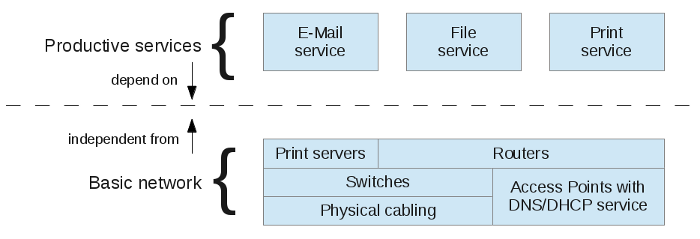In my eyes, it makes sense to divide the elements that are part of a SOHO (small office/home office) network into one of two layers:

In this model, if I were to speak about “the network” I’d mean what I call the basic network: all components that in their togetherness constitute an independent, foundational layer cornered around connectivity and, by comparison, low complexity (ie. no full-blown operating system on each device). This includes the physical LAN cabling (if present), network switches, print servers (usually integrated into the printers), WLAN access points and routers.
Because nowadays it is often essential for system administrators to have Internet access, be it for googling on problems that pop up or for bootstrapping installations that download software directly from the ‘Net (eg. in disaster recovery scenarios when no local mirror is present any more), I consider DNS and DHCP services to be essential enough to be part of the basic network as well.
With the advent of flash-based embedded devices such as WLAN access points and routers, the availability of OpenWrt as a standardized Linux distribution for these and the low resource consumption of DNS/DHCP, migration of these services from hard disk-based servers onto access points/routers became feasible. After all, an access point running on flash memory is much less likely to fail than a full-blown server with hard disks as storage. The only part I’ve seen failing over years with these devices is the $0.05 power supply.
The basic network is foundational in two ways: for one thing, it is independent, ie. can stand on its own. And the productive services layer, that encompasses more value-creating (to the end user) services such as File, Print and E-Mail services, is stacked upon it. No basic network, no productive services. And at the same time: no productive services, no real value in the basic network.
Formulating such a model helps in making up your own mind and communicating with others, eg. about the question where a service such as NTP should be placed. What do you think?